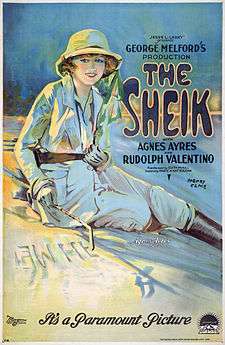George Melford
| George Melford | |
|---|---|
|
Who's Who in the Film World, 1914 | |
| Born |
February 19, 1877 Rochester, New York |
| Died |
April 25, 1961 (aged 84) Hollywood |
| Other names | G.W. Melford |
| Occupation | Actor, director, screenwriter, producer |
| Years active | 1909–1960 |
| Spouse(s) |
Louise Marsland (1904–1924) Diana Miller |
George H. Melford (February 19, 1877 – April 25, 1961) was an American stage and film actor, director, producer, and screenwriter. Often taken for granted as a director today, the stalwart Melford's name by the 1920s was, like Cecil B. DeMille's, appearing in big bold letters above the title of his films.
Career
Born in Rochester, New York, in 1877 (though older sources state 1888) as George Henry Knauff, son of German immigrant Henrietta Knauff (the name Melford was an adopted stage name). George Knauff Melford had four sisters: Mary Knauff (Mrs. Godfrey Willis Wainwright); Henrietta Knauff; Alice Irene Knauff (Mrs. Edmond Francois Bernoudy)--all of Los Angeles—and Mrs. Frederick Kells/Keils of Ottawa, Canada. Melford graduated from McGill University in Montreal, Canada. He was an accomplished stage actor working in Cincinnati, Ohio, before joining the Kalem Company motion picture studio in New York City in 1909. Hired by director Sidney Olcott for character actor roles, in the fall of 1910 he was sent to work with a film crew on the West Coast. In 1911, with Robert Vignola, he co-directed Ruth Roland in his first short film, Arizona Bill based on a script he had written. From there Melford went on to direct another 30 films for Kalem Studios until 1915, when he was hired by Jesse L. Lasky to direct feature-length films for Lasky's Feature Play Company. That same year Melford became one of the founding members of the Motion Picture Directors Association.

In 1916 Melford directed To Have and to Hold, a film based on the Mary Johnston novel that had been the bestselling novel in the United States for 1900. In 1921 he directed what is probably his most famous silent film—The Sheik, starring Rudolph Valentino.
Melford remained with Lasky's company for ten years, then joined Universal Pictures, where he directed his first talkie in 1929. The following year he co-directed four Spanish language films including the acclaimed Spanish version of Dracula. Melford filmed it simultaneously with the English version on the same sets at night using a different cast and crew. Somewhat of a controversy has arisen about this film. Some sources say that Melford was assigned the job because he could speak Spanish, but other sources claim that Melford could not speak a word of Spanish and had to use a translator to communicate with the actors. The issue was cleared up when actress Lupita Tovar—who was in the film—said in an interview on the 75th anniversary DVD of the film that Melford in fact did not speak Spanish and had to use a translator.
His last major work as a director came in 1937 when he and Harry L. Fraser co-directed Columbia Pictures' first serial, a 15-episode, five-hour-long adventure film titled Jungle Menace starring Frank Buck. At age 60 the workaholic Melford needed to slow down and decided to give up the stressful job of directing to take on simple character actor roles. However, in 1946 Harry Fraser convinced him to co-direct "Jungle Terror," a feature-length sequel to their successful Jungle Menace serial.
Later career and death
Melford loved the film business, and although financially independent, he never stopped working. Having directed more than 140 films, he continued to work in small character roles. In the 1940s he was part of Preston Sturges' unofficial "stock company" of character actors, appearing in six films written and directed by Sturges.[lower-alpha 1] He also made a notable appearance in the 1956 epic The Ten Commandments.
He appeared in his last film in 1960 at the age of 83, dying in Hollywood on April 25, 1961, of heart failure. He is interred in Valhalla Memorial Park Cemetery in North Hollywood, Los Angeles, California.
Select filmography
Actor
|
Director
|
Producer
|
Writer
|
Notes
- ↑ Melford appeared in The Great McGinty, The Lady Eve, The Miracle of Morgan's Creek, Hail the Conquering Hero, Unfaithfully Yours, The Beautiful Blonde from Bashful Bend, Sturges' last American film. Earlier, Melford had also appeared in Remember the Night, which Sturges wrote.
References
External links
| Wikimedia Commons has media related to George Melford. |
- George Melford at the Internet Movie Database
- George Melford at AllMovie
- George Melford at the TCM Movie Database

- George Melford at Find a Grave